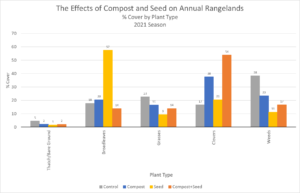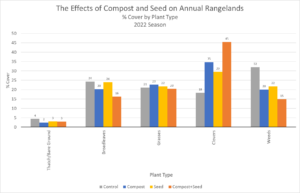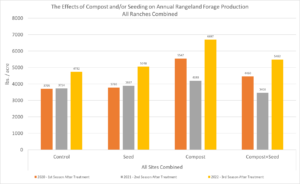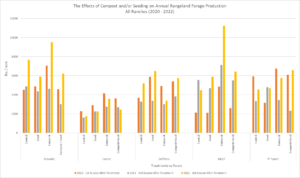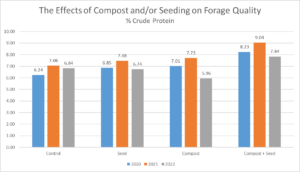Progress report for OW19-349
Project Information
The Amador Rangeland Soil Health Research and Education Project’s goal is to increase the implementation of best management practices that will improve soil health, and address a number of key issues facing livestock producers.
Livestock producers in the area are challenged with multiple landscape scale issues. Rangelands are typically on shallow soils that are nutrient poor and low in organic matter. Climate variabilities including winter drought and infrequent precipitation decrease winter forage availability and the length of the growing season. As a result, invasive weeds thrive and outcompete desirable vegetation. These compounding issues result in less forage for livestock and make it economically difficult for producers.
Studies have shown a direct benefit from the one-time application of compost to rangelands, including increases in water holding capacity, forage productivity, and carbon sequestration (Silver et al 2010, Ryals and Silver 2013). Based on these preliminary studies, the research component of the project will further test the one-time addition of compost to annual rangelands in an area that currently lacks localized data. By adding compost to the soil, we expect to increase soil fertility and water holding capacity which will ultimately increase the ability of desirable vegetation to be more resilient to climate variability and better able to compete against noxious weeds. In addition, the added fertility will make desirable forage more nutritious and more abundant for livestock, ultimately resulting in a financial benefit to the producer.
The essences of a successful outreach effort precipitates from the ability to provide real-word, ground-truthed information to producers. The research component will provide localized data and demonstrations of outcomes. This data and on-the-ground demonstrations will be used in on ranch tours to educate livestock producers, agricultural professionals, policy makers, elected officials and other land managers regarding the benefits of particular soil health best management practices.
- Provide localized data on the effectiveness of a one-time application of compost on annual rangeland using the following parameters:
- Species composition
- Forage production
- Forage quality
- Soil aggregate stability
- Organic matter
- Infiltration rates
- Organic carbon
- Determine if the application of compost on rangelands can increase the resiliency of desirable forage species to outcompete the noxious weed medusahead (Taeniatherum caput-medusae)
- Determine if the application of compost on rangelands can extend the growing season of desirable forage species
- Determine if reseeding with desirable forbs and/or the addition of compost will increase forage quality and quantity.
Objectives 1-4 will be achieved by conducting research on five livestock ranches in Amador County. Compost and seeding application with take place in 2019 on five (5), five (5)-acre plots. Data collection and analysis will be conducted over three years, 2020, 2021, 2022.
- Increase understanding and the ability of local agricultural professionals and producers to assist producers in the implementation of ‘carbon farm planning’ and soil health best management practices by providing farm tours and workshops detailing the results of the conducted research. This will be achieved through the hosting one (1) project kick-off meeting, Five (5) ranch tours on the research sites throughout the project, and a booth at the Amador County Fair for two (2) years. At least five (5) outreach materials will be developed including: two (2) power point presentations, one (1) soil health fact sheet, one (1) cost benefit analysis fact sheet and (2) press releases to be distributed locally and statewide.
- Develop cost/benefit analyses for compost application on rangeland incorporating known local barriers, market information, and local data on increased soil health benefits to be provide to producers.
|
Project Timeline |
|||
|
Start Date: June 1st 2019 End Date: June 1st 2022 |
|||
|
Year |
Month |
Objective |
Milestone Description |
|
2019 |
June |
Objective 5 |
Kick-off Meeting |
|
2019 |
July |
Objective 1-4 |
Sampling Protocol establishment conference |
|
2019 |
August |
Objective 1-4 |
Plot site finalization, prep for baseline soil testing and compost application. |
|
2019 |
Sept./Oct. |
Objective 1-4 |
Baseline soil sampling and treatment application |
|
2019 |
Sept/Oct. |
Objective 5 |
Soil Health Workshop/Application Tailgate. |
|
2020 |
April/May |
Objective 1-4 |
Vegetation & Soil Sampling |
|
2020 |
June/July |
Objective 1-4 |
Species Comp (mostly annuals) |
|
2020 |
June |
Objective 5 |
Amador County Fair Outreach Event |
|
2020 |
November |
Objective 5 |
Fall Range Tour |
|
2021 |
April/May |
Objective 1-4 |
Vegetation & Soil Sampling |
|
2021 |
May |
Objective 5 |
Spring Range Tour |
|
2021 |
June/July |
Objective 1-4 |
Species Comp (mostly annuals) |
|
2021 |
June |
Objective 5 |
Amador County Fair Outreach Event |
|
2021 |
November |
Objective 5 |
Fall Range Tour |
|
2021 |
November |
Objective 6 |
Develop cost benefit analysis using preliminary results |
|
2022 |
April/May |
Objective 1-4 |
Vegetation & Soil Sampling, Species Comp. |
|
2022 |
May |
Objective 5 |
Spring Range Tour |
Cooperators
- - Producer
- - Producer
- - Producer
- - Technical Advisor
- - Producer
Research
Objective. 1 – 4: Facilitated by University of California Cooperative Extension in collaboration with the Amador Resource Conservation District and cooperating ranchers.
The research component will be conducted on five livestock ranches in Amador County. The sites have been chosen based on varying soil types, slope, and tree cover. All are characterized by annual rangelands dominated by desirable annual grasses/forbs and the noxious weed medusahead. The research protocol is derived from the Conservation Field Trial (GM 403.3) Range Compost Application that was developed by the United States Department of Agriculture – Natural Resource Conservation Service, Davis CA.
At each site, three, 2-acre plots will be staked and marked with GPS coordinates. Each 2-acre plot will be divided in half, with one side receiving a one-time application of ½ inch layer of compost and the other side without compost. Each subplot will be further split into equal halves. One half will be seeded with a mix of clovers/legumes, and the other half will not be seeded. At the center of each one-acre plot will be an exclosure measuring 32’ by 32’. The entire two-acre plot will be grazed (except for the exclosure). Sampling will be taken along a 300’ transect that will bisect each subplot.
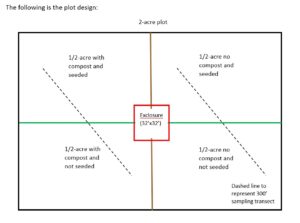
Baseline conditions will be measured and documented well inside the boundaries in order to account for edge effect. The following baseline items will be measured at each site:
- Soil carbon
- Lab analysis
- Species composition, using line-point intercept,
- 3000 ft. transect; data collection locations every 3 paces with up to three data points at each location
- Soil aggregate stability
- Slake test: ranked from 0 to 6
- Soil Series
- NRCS Web Soil Survey
- Peak vegetation production
- Biomass sampling of forage every 30 ft. with a 0.96 ft2 hoop on same 150 ft. transect used for species composition
- Infiltration rate
- Double-ring infiltrometer
- Compaction
- Penetrometer and observational data
- Total nitrogen in soil solution
- Spectrophotometer
- Bulk density
- Field and lab analysis;
- Soil texture
- Particle size analysis
- pH
- pH meter, electrode & probe
- Percent cover of medusahead
- Forage analysis
- Lab analysis
Within the exclosure, vegetation will be clipped annually at the end of growing season to characterize gross productivity and species composition.
In each 2-acre plot, (3) monitoring transects will occur:
- On the ½ acre compost treated side with seeded and non-seeded
- On the ½ acre no compost side with seeded and non-seeded
- Within the excluded subplot
Objective 5: Facilitated by the Amador Resource Conservation District with advisory roles for producers and University of California Cooperative Extension.
Objective 6: Joint effort between Amador Resource Conservation District, producers, and University of California Cooperative Extension.
One of the goals was to determine if the addition of compost either alone or in combination with desirable cover crop seed could increase the amount of clovers (which would ultimately be better for range conditions in the long term as it would fix nitrogen in the soil. The other factor was would either of those treatments have an impact (negative or positive) on invasive weed populations. The weeds of concern included yellow starthistle, medusahead, barb goatgrass, ripgut brome. We also were curious about the quantity of forage and the nutritional value of the forage.
- In 2021, two years after treatment we saw a 217% increase in the amount of clover across all ranches in the compost + seed treatment. This is very drastically different than when you just put seed out on the rangeland. In the seed only treatment we only saw 23% more clover (going from 17% cover in the untreated to 21% cover in the seed only treatment). The compost + seed on the other hand had 54% clover. In the compost only treatment we saw an increase in clover establishment. Meaning the clover seed is there, it just is not able to compete with the grasses and other broadleaf plants. With the addition of compost only, we saw an increase in clover from 17% to 38% which is a 123% increase.
- When it comes to the effects of compost and cover crop seeds on noxious weeds, we also saw some interesting trends. In 2021, across all ranches we had 38% cover on noxious weeds in the untreated plots. When we add compost only, we saw a decrease of 39% in total weed cover (38% down to 23%). In the seed only we also saw a decrease in weeds from the control, meaning the addition of cover crop seeds does compete with invasive weeds. In the compost + seed treatment we also saw a drastic 55% decrease in weed cover, going from 38% cover in the untreated to only 17% cover in the compost + seed.
Keeping on the same theme as above, in 2022, the third year after treatment, we saw very similar trends as in 2021. In terms of percent clover, we saw nearly identical trends in all treatments. Clover was lowest in the untreated plots (18%) and we saw the highest amount of clover in the compost + seed treatments 45%. This is again a 150% increase in clover from this treatment.
For noxious weeds, we again saw a nearly identical trend as in 2021. Noxious weeds were highest in the untreated plots were we had 32% cover of weeds. In the compost only and seed only treatments we saw a 37% decrease in weeds in each of those treatments, but the greatest decrease in weeds was in the compost + seed treatment where we saw a 53% decrease in weed cover.
As for forage production, the below graph shows what forage production did across all 5 ranchers over the entire project. Each color represents a year, so for example compare all the blue bars as a unit and all the orange bars as a unit. Across all years, the seed only treatment was no different than the control plots. As for the compost only and the compost+seed, in general we saw an increase in forage production in both those treatments in all years as compared to the control. For example, in the compost only treatment we saw a 33% increase in forage in the first year after treatment, a 11% increase in the second year two, and a 29% increase in year three, for an average increase of 25% over the control. For the compost plus seed treatment again we saw an increase in every year (except one), for a total average increase of 8% over the control. There were more significant increases at individual ranches, and that graph is also below.
In terms of forage quality, the compost+seed treatment had the highest crude protein every year. On average (across the three years), crude protein was 25% higher than the control plots.
Research Outcomes
Education and Outreach
Participation Summary:
The Amador RCD, UCCE and ranchers have been successful in the third, and final, year of this project accomplishing the goals planned for this project that were possible to achieve. COVID-19 restrictions and event cancellations, out of the hands of ARCD, have caused difficulties in accomplishing outreach event deliverables.
A kick-off meeting was held at PT Ranch, which is one of the research sites. All ranchers were in attendance. The kick-off meeting held on June 13th 2019 provided a review the goals of the project and answered questions of the ranchers (Event Photos). An article highlighting this project was included in the Summer 2019 Farms of Amador Newsletter (Summer 2019 Farms of Amador Newsletter_ SARE article). On October 15th 2019 an outreach event was held on PT Ranch in conjunction with the California Rangeland Trust. The event had a total of 80 people in attendance. The compost had been applied at PT Ranch and this project highlighted during this event, both ARCD District Manager and UCCE Farm Advisor discussed the project (Event Photos).
The Spring 2021 tailgate was held on May 22, 2021. This workshop was the most extensive of the project. The workshop was held at Circle Ranch, a SimAngus seedstock producer and participant in the Western SARE funded Amador Soil Health Research & Education Project. Spencer Smith, accredited Savory Institute Field Professional and Modoc County rancher, presented at an all-day workshop examining the ways in which grazing management can be used as a tool for increasing productivity, profitability, and ecosystem health. Scott Oneto presented on the current findings of Western SARE funded Amador Soil Health Research & Education Project. Following the workshop, participants interested in seeing holistic management applications in different contexts were invited to follow along for two additional days of site visits at ranches in the region. This all-day workshop hosts 38 people, 12 people participated in the following days of more extensive site visits.
The final Field Day was held on May 16th 2022 at one of the participating ranches, PT Ranch. In this workshop ARCD and UCCE discussed the results of a Western SARE project studying the effects of compost application and range seeding on ranches across Amador County. This event also provided an overview of Healthy Soils Program (HSP) work plans and implementation requirements. All participating ranchers were invited as well as people awarded past HSP funding to provide a rancher-to-rancher opportunity to discuss the project outcomes and upcoming funding opportunities. This event was attended by 30 people.
(Final Report #3 event photos)
Spring 2020 follow-up data was collected on forage productivity, forage quality, and plant diversity. In 2020, 2021 and 2022 a report summarizing this data was created and shared with partners, ranchers, and interested members of the public (Compost on annual rangelands annual report 2020) (Compost on annual rangelands 2021 Report) (Compost on annual rangelands 2022).
In response to COVID-19 restrictions the planned fall tailgates was cancelled. ARCD and UCCE developed a video update that was distributed and is available on the ARCD website, to meet this deliverable (video link). The 2020 Amador County Fair was cancelled.
ARCD participated in the 2021 & 2022 Amador County Fair. ARCD provide information on the current results of the project at the fair booth. The ARCD estimate interaction with 2000 members annually of the public at these events.
Several email updates to the ARCD newsletter email list and facebook have been circulated and a newsletter article in the Summer 2019 Farms of Amador Newsletter was published. An annual report of data results was created and distributed for 2020, 2021 and 2022. UCCE and ARCD developed a document titled “Compost on Rangelands – Lessons Learned from Amador County Healthy Soils Project.” This document discusses on the associated costs with compost application given local resources and points out potential benefits as identifies in the research project.
